Conception and Formation Of Fetus As Per Ayurveda
Article by Dr Raghuram Y.S. MD (Ay) and Dr Manasa, BAMS
Table of Contents
Introduction
Male cell (sperm) meets female cell (ovum), they unite, they divide, different segments and fragments are formed leading to the formation of organs and organ systems and this combination gets a life!!
Looks like a heard story isn’t it?
Of course, we all know this story; we all have come into this world following the above said script!!
The whole human creation is a product of 2 cells, a sperm and an ovum and the chemistry between them.
The amalgamation of male and female cells or gamates (sperm and ovum) is called zygote, which later gets the form of an embryo (unborn offspring in the process of development) and later when the cell division progresses towards clear differentiation and manifestation of body parts and organs; it will be called as foetus (prenatal human between the embryonic state and birth. There is a slow and steady process of this development of foetus which takes around 9 months time to get matured and fully formed, so as to get ready to be born.
Read related: Essential Elements For Conception – Garbha Sambhava Samagri
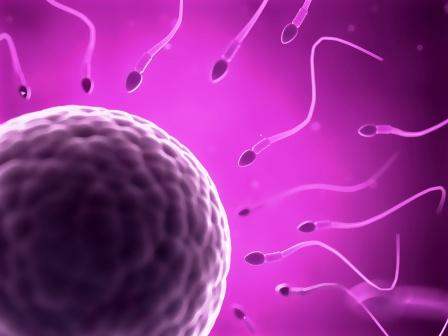
The formation of zygote and embryo and subsequent development of the embryo into foetus in various stages of development and maturity over a period of 9 months is called Garbha in Ayurveda. The whole process is called Garbha utpatti or Garbhavakranti (development and maturity of foetus). This constitutes the basics of the earliest embryology known to the mankind i.e. ‘Ayuvedic Embryology’ or ‘Garbha Sharira’.
Formation of Garbha
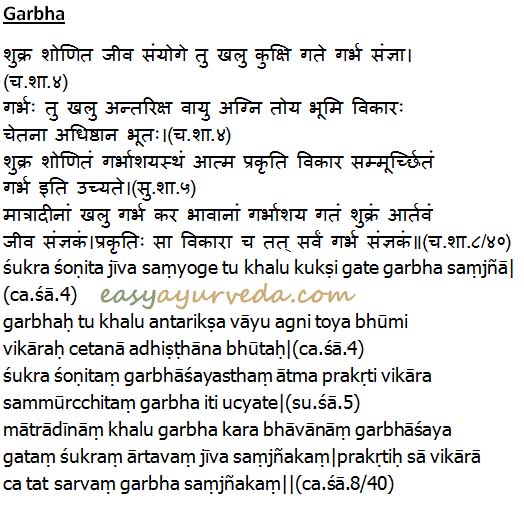
In this article I would like to cover the ‘formation of Garbha’ as explained in Ayurveda.
Garbha is formed by the combination of –
- Shukra – semen (sperm, male reproductive cell)
- Shonita – ovum (female reproductive cell)
- Aatma – soul (life element, the self consciousness)
- Prakriti – Primordial substance (substance used in the creation of an organism, in fact all organisms of the body)
- Vikara or Vikriti – derivatives of primordial substance (including Pancha Maha Bhutas or 5 basic elements of nature)
The union of all the above said factors in the Garbhashaya (healthy womb, uterus) is called Garbha.
Garbha is also defined by Charaka as ‘The union of shukra (semen or sperm), shonita (ovum) and jeeva (atma or soul) in the kukshi or uterus’
Another definition from Charaka defines Garbha as union of the below mentioned factors in the garbhashaya (uterus) –
- Matrujadi Garbhakara Bhavas (factors derived from father, mother, mother’s food or foetal circulation, self, from the mind of subtle body or sukshma shareera and acclimatization and habits)
- Shukra – healthy sperm
- Artava – healthy ovum
- Prakruti – primordial substance
- Vikaras – derivatives of prakriti
- Jeeva – soul
Factors forming Garbha
Shukra
Semen or sperm is the most important component helpful in the formation of Garbha. It is the contribution of man towards formation of garbha. Shukra is the 7th dhatu (tissue) formed in the sequence of formation of tissues (according to Ayurvedic chronology of tissue formation). It carries vital components and memories of the previous 6 dhatus i.e. Rasa (digestive essence, lymph, and plasma), Rakta (blood), Mamsa (muscle), Meda (fat), Asthi (bones) and Majja (bone marrow). Thus it helps in the formation of the same tissues in the body which it creates after its union with artava. Of course, the Artava too contributes towards the formation of body and body parts.
Shuddha Shukra – is the clean, clear, healthy and sterile form of shukra. This uncontaminated form of shukra is needed to produce a healthy embryo. If the shukra is not sterile and healthy, the embryo or foetus formed will not be healthy, in fact it will be diseased and deformed, which manifests in the form of congenital disorders.
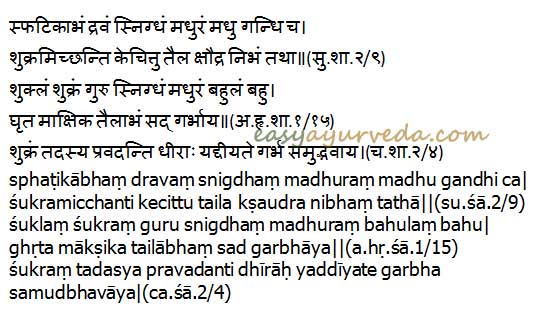
Characteristics of Shuddha Shukra
Below mentioned are the characteristic features of shuddha shukra (uncontaminated or pure semen) –
- Sphatikaabham – appears like a sphatika (quartz stone), crystalline in shining
- Dravam – liquid in consistency
- Snigdham – unctuous or viscous in consistency
- Madhuram – sweet in taste
- Madhu gandhi – smell of honey
- Taila kshaudra nibham – resembles with that of a mixture of taila (oil) and kshoudra (honey)
- Shukla – white in colour
- Guru – heavy or viscous
- Bahulam – more in quantity
- Ghrutabham – appears like ghee
- Yad dheeyate garbha samudbhavaya – has a capacity to produce garbha
Shonita, Artavam:
Artava or ovum is the second component essential for the formation of Garbha. It is the contribution of woman towards the formation of Garbha. Just like Shukra, it is said that artava or raja too should be shuddha (clean and sterile, uncontaminated). Only shuddha artava is supposed to contribute towards conception of healthy foetus.
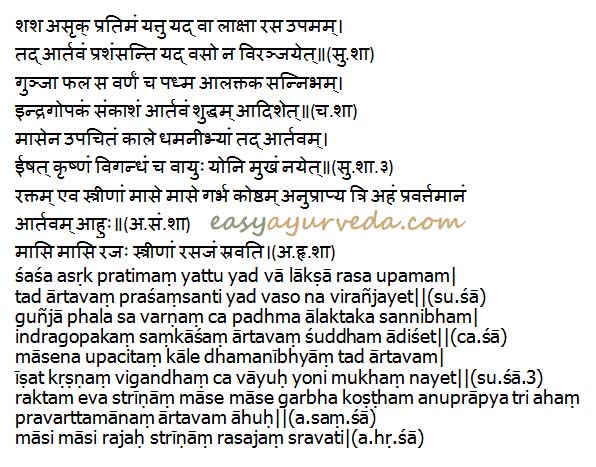
Characteristics of Shuddha Artava
Below mentioned are the characteristic features of Shuddha Artava –
- Shasha Asruk Pratimam – resembles the blood of hare (rabbit)
- Laksha rasa / alaktaka upamam – resembles liquid lac in appearance
- Gunja phala savarnam – has colour and resembles that of fruit of Gunja (Abrus precatorius)
- Padma sannibham – resembles colour of lotus flower
- Indragopa sankaasham – resembles the colour of a fire-fly
- Eshat Krishna – slightly dark in colour
- Vigandhi – emits peculiar odour
Further –
- Artava which is accumulated for a month is drawn towards the vaginal orifice by Vata through the dhamanis (blood vessels, channels).
- It is slightly dark in colour and emits peculiar odour.
- The rakta dhatu (blood tissue) itself flows as artava in women.
- Every month rakta dhatu accumulates in garbhashaya (uterus) and gets discharged for 3 days in the form of artava (menstrual blood).
- Artava is said to be an upadhatu (sub-tissue) of rasa (essence of nutrition) in females. It accumulates in the garbhashaya and gets discharged once in a month through yoni or vagina.
- Its main objective is production of garbha.
This explanation points towards –
Artava – as menstrual blood, which flows out once in a month
Artava – as ovum, which is responsible for conception or formation of garbha
Both the concepts are acceptable. Release of ovum is a part and parcel of menstrual cycle. If the monthly periods are good and fine (healthy monthly cycle in woman) in terms of quality and quantity, Ayurveda believes that the woman’s body is cleansed in a good way. This further is a proof of the artava (ovum) to be healthy, matured and ready to conceive. The periods also keep the kshetra (garbhashaya or uterus), where the implantation of the zygote takes place after conception, clean and sterile. Seeing the other way, healthy ovulation signifies good menstrual cycle and a balanced and synchronized hormone system. All these criteria need to be fulfilled if a healthy embryo is to be formed.
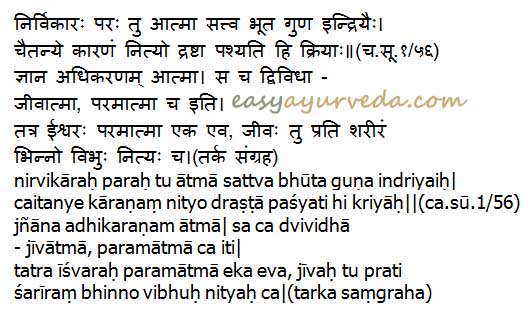
Atma
Atma – the soul or life element
Atma means soul, the life element. The garbha gains life and life-related activities only after the entry of Atma into it. Following are said to be characteristics of Atma –
-Nirvikara – devoid of deformity
-Para – minute, invisible, endowed with best qualities, different from shareera (body) and satva (mind)
-Nitya – indestructible, atma doesn’t get destroyed (eternal) in spite of the body getting destroyed (death)
-Drashta – spectator, atma being a spectator, keeps witnessing each and every activity pertaining to the body and mind.
This Atma consists of chaitanya or life element. Atma, on getting associated with sattva (mind), bhuta gunas and indriyas, manifests the chaitanya in the inert body. Henceforth, the life-related-activities begin in the garbha.
Atma is an abode of gnana or knowledge. All the knowledge of our life time is stored in the atma (even the knowledge from our previous incarnations).
Atma is of 2 types –
Paramatma – the greater atma, called ishwara or God
Jeevatma – the smaller atmas, many in number, all living beings have this atma, this is derived from Paramatma (branches of Paramatma), Jeevatma comes from Paramatma and goes back to Paramatma after death of an individual
Prakriti
Prakriti – Primordial substance (substance used in the creation of an organism, in fact all organisms of the body)
Prakritis are 8 in number. They are primordial substances which amalgamate to form the preliminary creation of an organism. They are –
- Avyakta – Microcosm or miniature universe (humankind is regarded as the representation in miniature of the universe), This factor signifies that we are representing the universe in a small form or miniature form and we have all the elements making it.
- Mahan or Mahat (collective intelligence) – Cosmic intelligence, the ‘intelligence needed to create’ in the universe. This is represented in us in the form of intelligence.
- Ahankara – Egoism, or the cosmic egoism, which claims that whatever created is ‘mine, my creation!’ We all carry the miniature part of this egoism in us.
- Shabda tanmatra – Root of Sound (sensation)
- Sparsha Tanmatra – Root of Touch (sensation)
- Rupa Tanmatra – Root of Vision (sensation)
- Rasa Tanmatra – Root of Taste (sensation)
- Gandha Tanmatra – Root of Smell (sensation)
Note – Shabda to Gandha Tanmatra are represented in us in the form of subjects of sense organs. They are collectively called as Pancha Tanmatras.
Vikriti
Vikara / Vikriti – derivatives of primordial substance (including Pancha Maha Bhutas or 5 basic elements of nature)
The derivatives of the above said primordial substance (prakriti) are called Vikara or Vikritis. They are 16 in number. They are as mentioned below –
- Shabda indriya or Shravana indriya – Sense Organ of hearing, ear
- Sparshana Indriya – Sense Organ of touch, skin
- Rupa indriya or Chakshu indriya – Sense organ of sight or vision, eye
- Rasana indriya – Sense organ of taste, tongue
- Gandha indriya or Ghrana indriya – Sense organ of smell, nose
- Vak indriya – Motor organ of speech
- Pani indriya or Hasta indriya – Motor organ of grip, hands
- Pada indriya – Motor organ of locomotion, foot
- Payu indriya – Motor organ of excretion, excretory system
- Upastha indriya – Motor organ of sex, sexual organs or genitals
- Ubhaya Indriya or Manas – The mind, which is both, sensory and motor organ
- Prithvi Mahabhuta – Earth element
- Ap or Jala Mahabhuta – Water element
- Tejas or Agni Mahabhuta – Fire element
- Vayu Mahabhuta – Wind element
- Akasha Mahabhuta – Sky or Ether or Space element
Note:
- Shabda indriya to Ghrana Indriya are called as Pancha Gnana indriyas or 5 sense organs.
- Vak indriya to Upastha indriya are called Pancha Karma indriyas or 5 motor organs.
- 5 Gnana indriyas and 5 karma indriyas together with Manas are called Ekadasha Indriyas or 11 indriyas
- Prithvi Mahabhuta to Akasha Mahabhuta are called Pancha Mahabhuta or 5 elements of nature or creation
- Prakritis are called Karanas (causative phenomenon) which create Vikritis. Vikritis are called Karyas or derivatives of Prakritis. Prakriti and Vikriti have Karana-Karya Smabandha i.e. Cause and effect relationship.
The above said 24 Tatvas i.e. 8 Prakritis and 16 Vikritis are inert amalgamation of elements needed to create a life. When these are joined by or ignited by a life force called as Jeeva or Jeevatma or Purusha (soul, the life element), the Garbha with life is manifested, and starts’ living (life activities) in the womb until it is born.
Role of Panchamahabhuta
Role of Panchamahabhuta in the formation of Garbha
We are all composed of Panchamahabhutas or 5 basic elements of the nature. When the combination of Panchamahabhuta is impregnated with life element or Atma, we adorn life and exhibit life activities. Panchamahabhutas have a pivotal role in the formation of body and are involved at various stages of development of garbha. (The concept can be considered as Ayurvedic versions of cell division and embryology). Below said are the roles of Panchamahabhutas in the formation and development of Garbha –
- Vayu Mahabhuta is involved in Vibhajana Karya – It divides the Garbha into different fragments (cell division)
- Teja Mahabhuta is involved in Pachana Karya – It helps in processing and bringing about maturity of Garbha
- Apa Mahabhuta is involved in Kledana Karya – It helps in nourishing the Garbha and its components (foetal nourishment)
- Prithvi Mahabhuta is involved in Samhanana Karya – It helps in bringing about integrity and maintains the grouping and compactness of cells under division
- Akasha Mahabhuta is involved in Vivardhana Karya – It helps in coelomicity of foetus. This provides space or cavities for different organs, vessels, ducts, tubes etc.
What else adorns Garbha?
The Garbha or shareera (body) inherits the qualities of Purva Janma (previous incarnation). Chetana Dhatu (Jeevatma or life element) while leaving out the previous body carries along with him the impressions in the form of five sense organs and manas.
Inheritance of Matruja adi bhavas
The characters and inborn qualities of a man may be from different sources. These are –
- Pitruja Bhavas (from father) – hard and stable structures like scalp hair, moustache, skin hair, bones, nails etc
- Matruja Bhavas (from mother) – delicate and soft tissues like muscle, blood, fat, and soft organs like heart, liver etc
- Rasaja Bhavas (from mother’s food, foetal circulation) – like growth of all the tissues, complexion, life, decay, death etc
- Atmaja Bhavas (ones own) – sense organs and their perceptivity, spiritual knowledge, material knowledge, life, pressure, pain etc
- Satvaja Bhavas (from the mind of sookshma shareera) – constitutional qualities gained by the predominance of one or more mental qualities viz, Satva, Raja, Tama gunas
- Saatmyaja Bhavas (from acclimatization and habits) – stamina, health, strength, complexion, intelligence etc
Shareera
Shareera, the physical body – Garbha gets the name of shareera (physical body) when when the amalgamation of shukra, shonita, atma, prakriti and vikriti in the garbhashaya (uterus or womb), after the action of panchamahabhutas and after acquiring (inheriting) the qualities of purva janma and matrujadi bhavas, start developing hasta (hands), pada (lower limbs), jihwa (tongue), ghrana (nose), karna (eyes), nitamba (butts, pelvis), etc organs. This means to tell that, garbha will be called as shareera once the organs start getting manifested in a visible and clear way.
Just Before Finish –
Ayurvedic embryology is an interesting branch. Ayurvedic Acharyas (teachers) of ancient time have explained the concepts of conception, formation of zygote and foetus, the inheritance of various qualities, formation of different organs and system and monthly development of foetus in a subtle, detailed and interesting way. Garbha Shareera is a proof of the unparalleled knowledge, the ancient Ayurvedic teachers had regarding the embryology!!
Click to Consult Dr Raghuram Y.S. MD (Ayu)
Does fetus have life?
I was studying the lesson 161, about the origin of Charaka Samhita and Ayurveda, and then came to me this slide, which says –
Combination of body, senses (sense organs), mind and soul together is called life – ayu.
Having this information as the root source, I’d like to know how I could think of the abortion controversy in terms of Ayurveda. I know there is not any political judgement inside the samhitas, I just wanted to think about this matter through Ayurveda knowledge.
Thus, if I interpreted it correctly, there is only Ayu when Shareera, Indriya, Satva and Atma, altogether, are there and functioning. Talking about a fetus, that does have Shareera and Atma. but Indriyas are not functioning and Satva is asleep, can we call abortion a kill, through that logic?
Note that I really don’t want to polemicize, and I know that many Vaidyas may have different opinions on that matter, I just want to check with you if I am correct on applying this logic through the concept of Ayu.
Dr JV Hebbar:
Thanks for the great question.
1. Fetus has soul
शुक्रशोणितजीवसंयोगे तु खलु कुक्षिगते गर्भसञ्ज्ञा भवति||५||
śukraśoṇitajīvasaṃyoge tu khalu kukṣigate garbhasañjñā bhavati||5||
Charaka Samhita, Shareera Sthana 4th chapter, Shloka 5.
Sperm and ovum, when unite and at the same moment, when the Jeeva (soul) joins in the womb, then Garbha gets formed, then conception happens.
So, Embryo from day 1, has a soul.
2. Fetus has mind
मातृतः पितृत आत्मतः सात्म्यतो रसतः सत्त्वत इत्येतेभ्यो भावेभ्यः समुदितेभ्यो गर्भः सम्भवति|
mātṛtaḥ pitṛta ātmataḥ sātmyato rasataḥ sattvata ityetebhyo bhāvebhyaḥ samuditebhyo garbhaḥ sambhavati| Charaka Samhita, Shareera, 4/4
Embryo has influence of maternal, paternal, soul, habits of parents, quality of Rasa dhatu and Satvataha – influence of mind factors on it.
So, it is evident that the embryo has a mind, albeit in seed form.
3. Fetus has a body (Shareera). It is in the developing stage, but still the fetus has a body.
5. Fetus has sense organs, though in an early developing stage. Sense organs are luxury items.
Sense organs do not matter much. A blind, though lacking vision, still life is intact. Even a patient in coma, though all sense organs and mind stop functioning, still life is intact, because the soul has not left the body.
We have learnt from the great example of Abhimanyu, son of Arjuna and Draupadi, how he learnt half of a special warfare technique called Chakravyuha, from God Shri Krishna, in the womb of Draupadi. Modern research as proven that fetus responds to touch and voice (1)
With all, it is pretty evident that the fetus has life.
Abortion has specific ethical use-cases, despite what is said above is true. For example rape survivor, a fetus with severe deformities, teen pregnancy etc.
Read:
Conception And Formation Of Fetus As Per Ayurveda








